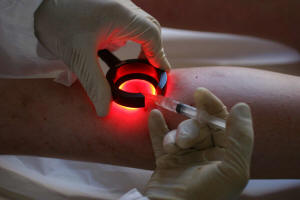|
|
The fact that an opinion is strongly
supported |
|
American College of Phlebology reviews Questions and answers for medical professionals (FAQ) Three-dimensional Regenerative Ambulatory Phlebotherapy (T.R.A.P.) (English) La Phlébothérapie Régénératrice Tridimensionnelle Ambulatoire (T.R.A.P.) (Français) Fleboterapia tridimensional regenerativa ambulatoria (T.R.A.P.) (Español) Dreidimensionale regenerative ambulante Phlebotherapie (T.R.A.P.) (German) Fleboterapia Regenerativa Tridimensional em Ambulatório (T.R.A.P.) (Portuguese-Brazil) |
Why obliterate or remove the
veins when they can be cured? American College of Phlebology reviewsThis is the second review by the American College of Phlebology. On the basis of this review, my paper, which was almost identical to the version published in the Appendix to the Proceedings of the World Phlebology Congress (15thWorld Congress Rio) was rejected. The reasons for rejection are followed by my observations. I have now (March 2006) decided to set up an Internet "Forum" to question the deeply-rooted concepts that have, until today, guided phlebological treatments. This Forum will enable us to answer the questions raised by those wishing to know more about our proposed treatment for venous insufficiency: Three-dimensional Regenerative Ambulatory Phlebotherapy (T.R.A.P.). We believe that superficial veins dilate as a result of hemodynamic hypertension caused by the miopragia of the walls of the perforating vessels, the valves of which, on account of this dilation, are no longer continent. Incontinence is, for the most part, dynamic, becoming static only subsequently (Indeed, most perforating veins are not visible on Colour Echo-Doppler). Three-dimensional regenerative phlebotherapy treats the perforating circulation with a non-aggressive solution. The solution reaches its target through the "gateways" constituted by the superficial vessels, which are visible to the naked eye or by means of transillumination. Injected through all such gateways (truncal veins, reticular veins and telangiectasias), the solution reinforces, shrinks and "regenerates" the walls of the perforating vessels responsible for the visible pathology. No longer subjected to anomalous hypertension, the superficial circulation simply disappears from view. This result is permanent. T.R.A.P. is an injectable cure which respects the functional anatomy of the circulation. Moreover, in such a complex three-dimensional network of tubes as the venous circulation in the lower limbs, what could be more efficacious and less traumatic than injecting the cure through the tubes themselves? To American College of Phlebology 06.03.06 Dear Sir, R) Weak sclerosant solutions can routinely produce fibrotic
change without complete obliteration in the walls of treated
vessels. R) In addition, fibrotic changes resulting in condensation of
vascular lumina are a common outcome of endovenous laser and
EVLT therapy. R) There’s nothing in this article which suggests that “regeneration”
is occurring. R) Fig. 1 which purportedly shows a “normalization” of a
vessel could also be interpreted as a coexisting normal vessel
in the treated area. R) No drug is completely without side effects. R) Acetylsalicylic acid has caused focal hemorrhage and cell
death in rats and certain types of seizures (Neuroscience 2000
991:1-17). R) The assertion that T.R.A.P. constitutes a “step forward”
is most certainly immodest and not supported by the data
presented in this article. Conclusion:R) The theories presented are interesting but do not provide
credible support to the superiority of this technique over other
accepted alternative protocols.
sergio.capurro@fastwebnet.it
|


